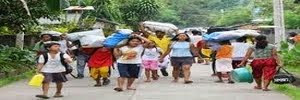From the Website of RAPPLER
links: https://www.rappler.com/nation/224655-deped-urges-parents-monitor-kids-online-activity-momo-challenge-viral
DepEd, DOH to parents: Monitor kids' online activity as 'Momo challenge' goes viral
Education officials ask parents to pay attention to online activities of their children to avoid harm that may stem from viral online content

MANILA,
Philippines (UPDATED) – After reports of a viral “Momo challenge” trend
urging children to commit harmful acts went viral online, the country's
education department urged parents to pay attention to the online
activities of their children.
The Department of Education said parents should maintain “open
communication lines” with kids to allow children to inform and trust
them with matters that may make them feel “uncomfortable, coerced, or
unsafe.”
Doing so, they said, will allow parents to inform kids about safe and responsible online behavior.
The Department of Health (DOH) also advised parents to montor their kids' social media habits and what sites that they visit. It encouraged parents to set boundaries on the use of media devices at home and to find ways to make technology habits productive for their children, such as by being involved in their children’s internet activities.
The 'Momo challenge'
The viral Momo meme is distilled from combination of events, as explained by meme cataloguing page KnowYourMeme.
The challenge is composed of two primary things: the visual representation of "Momo" and the urban legend representing the challenge.
The visual representation of Momo comes from cropped images of a sculpture made in 2016 by artist Keisuka Aisawa. The complete picture features the creepy face taken to be Momo sporting a bird-like body and legs, much like what one would associate with a mythological harpy.
The Momo challenge itself takes pictures of the scuplture and associates it with an urban legend that says a given Whatsapp number will attempt to users with disturbing photographs and urge self-harm if contacted.
The idea of the Momo challenge first spread in July 2018 then eventually died down. It resurfaced in February 2019 though after Scottish website The Herald said a mother from Edinburgh claimed her 8-year-old son was told by someone using the Momo image to hold a knife to his neck.
Tweets from a number of sources, as well as YouTube videos that discussed the Momo challenge – or the concept of the harpy image and the urban legend combined – spread the meme and its idea further, placing it back in the public consciousness.
YouTube, speaking with tech and culture website The Daily Dot, responded to concerns about the meme on February 27, saying, “Contrary to press reports, we’ve not received any recent evidence of videos showing or promoting the Momo challenge on YouTube."
“Content of this kind would be in violation of our policies and removed immediately,” YouTube added.
A report on hoax-debunking website Snopes meanwhile added that while the challenge may not be real, its effects may manifest in very real ways.
Aside from pranksters using the challenge to harm others or to goad others into self-harm, "anything that puts suggestions and images of self-harm and suicide in front of children who are already vulnerable to self-esteem and other psychological issues (including suicidal tendencies) can carry dangerous potential."
Stronger lessons
In light of the spread of fears regarding the possibility of the Momo challenge being real or otherwise used to harm others, the DepEd said all forms of abuse, exploitation, discrimination, bullying, and other forms of violence against children must not be tolerated.
They urged parents, teachers, and communities to “act united” to protect the youth from online risks..
“Distorted efforts meant to prey on the vulnerabilities of the youth should be resisted with proper guidance and education and by empowering the children with knowledge of their rights and responsibilities online and offline,” said DepEd.
DepEd gave assurances online safety was taught in schools for children to learn how to discern online issues, threats, and information. These skills were taught across all grade levels in all subject areas in the K-12 Curriculum.
The department likewise said it would continue to straighten the implementation of its Child Protection Policy, with an emphasis on online safety as a “crucial component.”
The Snopes report suggested acting preemptively to tackle such problems. It advised parents to let their kids know they can come to them if they find things online which they might find scary or otherwise threatening, allowing the family to discuss anything they find in a constructive manner which would lessen or negate the harmful impact of the offending content. – Rappler.com
Doing so, they said, will allow parents to inform kids about safe and responsible online behavior.
The Department of Health (DOH) also advised parents to montor their kids' social media habits and what sites that they visit. It encouraged parents to set boundaries on the use of media devices at home and to find ways to make technology habits productive for their children, such as by being involved in their children’s internet activities.
The 'Momo challenge'
The viral Momo meme is distilled from combination of events, as explained by meme cataloguing page KnowYourMeme.
The challenge is composed of two primary things: the visual representation of "Momo" and the urban legend representing the challenge.
The visual representation of Momo comes from cropped images of a sculpture made in 2016 by artist Keisuka Aisawa. The complete picture features the creepy face taken to be Momo sporting a bird-like body and legs, much like what one would associate with a mythological harpy.
The Momo challenge itself takes pictures of the scuplture and associates it with an urban legend that says a given Whatsapp number will attempt to users with disturbing photographs and urge self-harm if contacted.
The idea of the Momo challenge first spread in July 2018 then eventually died down. It resurfaced in February 2019 though after Scottish website The Herald said a mother from Edinburgh claimed her 8-year-old son was told by someone using the Momo image to hold a knife to his neck.
Tweets from a number of sources, as well as YouTube videos that discussed the Momo challenge – or the concept of the harpy image and the urban legend combined – spread the meme and its idea further, placing it back in the public consciousness.
YouTube, speaking with tech and culture website The Daily Dot, responded to concerns about the meme on February 27, saying, “Contrary to press reports, we’ve not received any recent evidence of videos showing or promoting the Momo challenge on YouTube."
“Content of this kind would be in violation of our policies and removed immediately,” YouTube added.
A report on hoax-debunking website Snopes meanwhile added that while the challenge may not be real, its effects may manifest in very real ways.
Aside from pranksters using the challenge to harm others or to goad others into self-harm, "anything that puts suggestions and images of self-harm and suicide in front of children who are already vulnerable to self-esteem and other psychological issues (including suicidal tendencies) can carry dangerous potential."
Stronger lessons
In light of the spread of fears regarding the possibility of the Momo challenge being real or otherwise used to harm others, the DepEd said all forms of abuse, exploitation, discrimination, bullying, and other forms of violence against children must not be tolerated.
They urged parents, teachers, and communities to “act united” to protect the youth from online risks..
“Distorted efforts meant to prey on the vulnerabilities of the youth should be resisted with proper guidance and education and by empowering the children with knowledge of their rights and responsibilities online and offline,” said DepEd.
DepEd gave assurances online safety was taught in schools for children to learn how to discern online issues, threats, and information. These skills were taught across all grade levels in all subject areas in the K-12 Curriculum.
The department likewise said it would continue to straighten the implementation of its Child Protection Policy, with an emphasis on online safety as a “crucial component.”
The Snopes report suggested acting preemptively to tackle such problems. It advised parents to let their kids know they can come to them if they find things online which they might find scary or otherwise threatening, allowing the family to discuss anything they find in a constructive manner which would lessen or negate the harmful impact of the offending content. – Rappler.com
OTHER HUMAN RIGHTS PROMOTIONS WEBSITES
Human Rights Advocacy Promotions | Human Rights
Home - Human rights Promotions Website
HUMAN RIGHTS PROMOTIONS
PROTECTION AND PROMOTION OF HUMAN RIGHTS
-----------------------------------------------------------------------------------------------
------------------------------------------------------------
-----------------------------------
------------------------------------------------------------
-----------------------------------


























































0 comments:
Post a Comment